Make bread, a new, simple and easy method
 This is a new simple and easy method that everyone can use at home. It is easy to make bread with this Batter and Dough method that I had invented. I do hope this Batter and Dough method does help everyone at home.
This is a new simple and easy method that everyone can use at home. It is easy to make bread with this Batter and Dough method that I had invented. I do hope this Batter and Dough method does help everyone at home.
If you had read my previous article on the Batter and Dough method to make bread, you would know that the beauty of this method is that you do not need to knead the dough to make excellent bread. The bread turns out moist and tender. In fact I had kept the bread for 5 days – eating it slowly, and it was still good. This means that it is possible to make bread without chemicals and without kneading.
I have been carrying out more experiments to see where are the limits to this Batter and Dough method and how to improve this process of making bread. If you have never made homemade bread before I would suggest that you begin with this Batter and Dough method as it is very easy to get good results.
If you would like to know more about bread methods and how to make bread please refer to these articles quick bread and how to make bread methods. You will realise that if you make homemade bread with my batter and dough method it will be much easier. Furthermore do read my article on how to make bread with self-raising flour. I explain the problems of over mixing flour. You will soon realize that if you do not over mix the bread flour when you make bread, the bread will be delicious and you may be able to smell the aroma of the wheat fields in the Parries. When you make bread at home with this method you will realise that many standard bread recipes can be converted to this batter and dough method. There is no kneading required when you make bread with the batter and dough method.
Make bread with the Batter and Dough method – simple and easy bread recipe
| Make bread with the Batter and Dough Method | ||||
| Item | Ingredients | Percentage | Weight | Weight |
| (%) | (g) | oz. | ||
| 1 | Bread Flour for Batter | 10 | 80.00 | 2.82 |
| 2 | Bread Flour for Dough | 90 | 720.00 | 25.34 |
| Subtotal | 100 | 800 | 28.16 | |
| Batter | ||||
| 3 | Cold water | 55 | 440.00 | 15.49 |
| 4 | Sugar | 2.5 | 20.00 | 0.70 |
| 5 | Instant Yeast | 1 | 8.00 | 0.28 |
| Dough | ||||
| 6 | Salt | 1.2 | 9.60 | 0.34 |
| 7 | Butter | 7 | 56.00 | 1.97 |
| Bake 25 minutes at 230C | 1,333.60 | 46.94 | ||
I wanted to make bread enough for two loaves hence the recipe above is twice my normal weights. You will notice that I had increased the salt content in the recipe to 1.2% as the previous recipe was slightly under salted.
There are to parts to make the bread with the Batter and Dough method. The first part is to make a very dilute batter and the second part is to add in the rest of the ingredients and to fold the dough on itself. After that put the dough into a baking tin and leave it alone for proofing. That is to allow it to rise and it will take about 4 hours, in general. Once the dough has risen bake it for 30 minutes at 230C (446F).
Photos of how to make bread with the Batter and Dough method
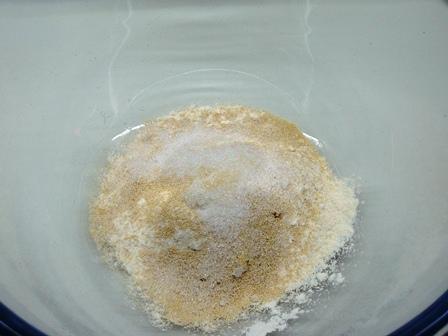
To make this bread weigh out the ingredients for the batter. That is the bread flour, sugar and yeast.
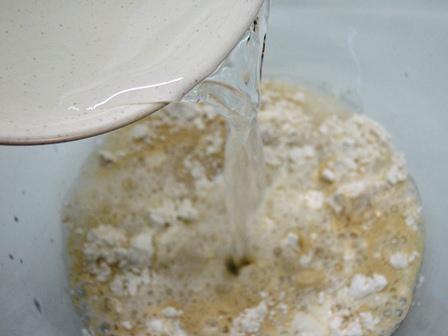
Pour in all the cold water in one go.
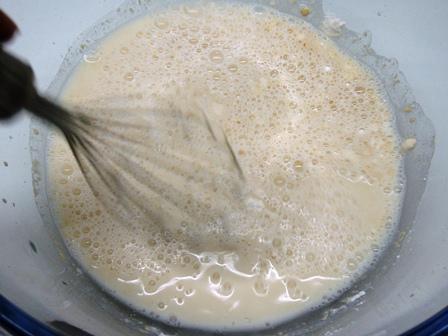
Whisk the ingredients so that it forms a solution and there are no lumps to be seen. Whisking for a few seconds would be sufficient. Then allow the solution to rest for half an hour and not any longer. This is the most critical step to make bread with the Batter and Dough method. This step allows sufficient gluten to form so that there is no need to knead the dough.
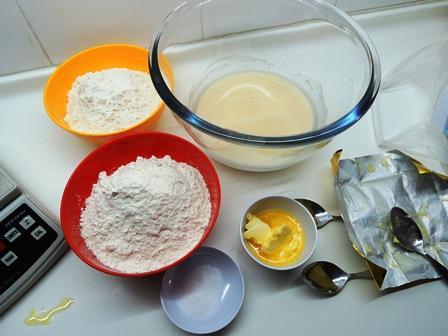
While you are waiting for half an hour for the gluten to form in the batter do weigh out the rest of the ingredients.
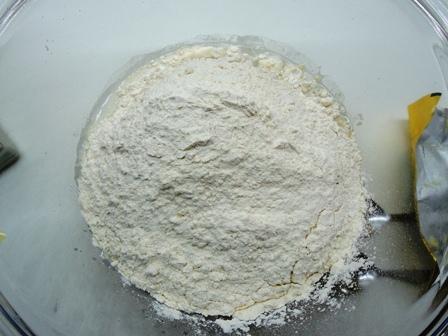
Once the half hour is up dump in all the bread flour and mix. This is to ensure the yeast reaches all the flour and the water is spread evenly through the flour.
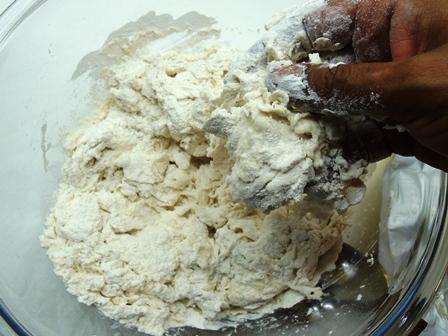
It just takes a few stirs by hand to get a sufficient good mix. You can see that I did a partial mix and not a full mix. This is to make it easier to mix salt and butter.
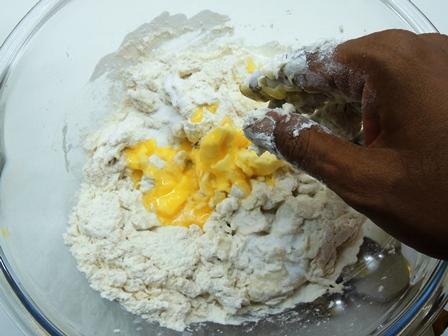
At this stage add in the salt and butter.
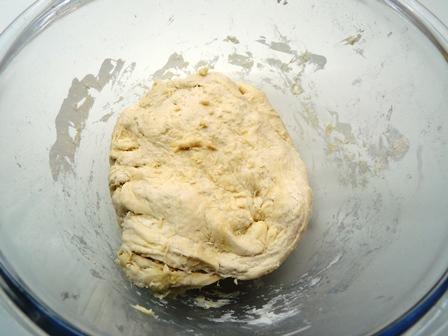
Fold the dough on itself and press down for about 5 to 20 times. This is sufficient to make a reasonably good mix.
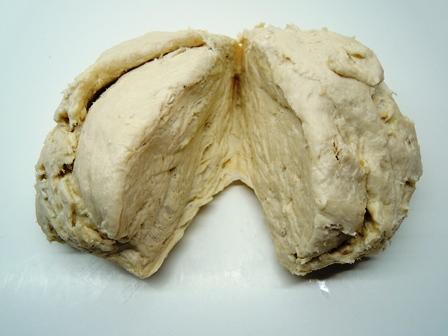
Cut the dough in half. I weighed each half to make sure they were the same weight. If they are not pinch some dough from the heavier half and added it to the lighter half. Can you see how beautiful the dough looks on the inside? Notice that I have not powdered the work surface with flour as the dough did not stick to my kitchen top.
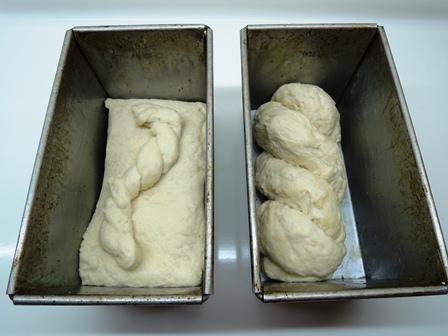
I rolled one half of the dough, the one on the right but I did not knead it. The one on the left I did some heavy kneading. This was to compare if there would be a substantial difference in the behavior of the dough with additional kneading. Actually, there is no need to knead the dough and there is no need to roll the dough into a twist. I did it to run the experiments and make them look different so that I knew which dough was which. All you need to do is to take the lumps of dough and place them into greased baking tins and allow them to proof for 4 hours.
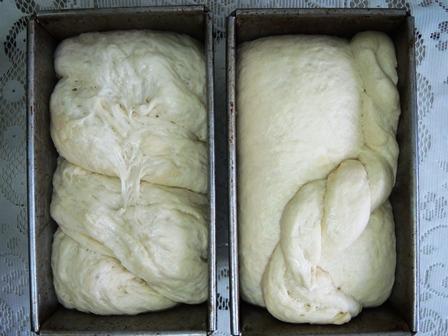
After 5 hours (I had dropped off to sleep) I noticed that the kneaded dough had risen slightly higher than the non kneaded dough. I did notice that the kneaded dough was slower to rise and I guess this is because the dough is a lot more ‘rubbery’ or elastic and hence needs a lot more gases to be released by the yeast for it to rise.
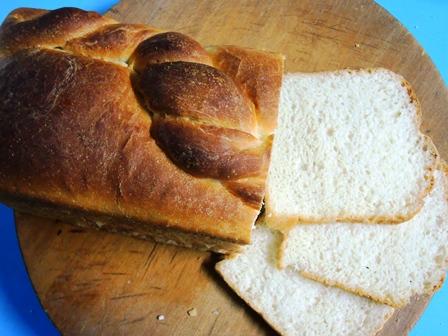
Here is the sliced bread. It is really simple and easy to make bread and I would suggest you make bread at home. You will be able to add herbs and spices and lots of other ingredients when you make bread at home. There are no limits when you make bread at home and best yet there is no kneading required when you make bread with this batter and dough method.
Batter and Dough Method for making bread – no kneading
4. How to make garlic bread the batter and dough method
3. how to make bread the batter and dough method
2. How to make bread with self raising or self rising flour a new method
1. How to make plain simple bread a new method
This article on how to make bread the batter and dough method was researched and written by Peter Achutha
Leave a Reply